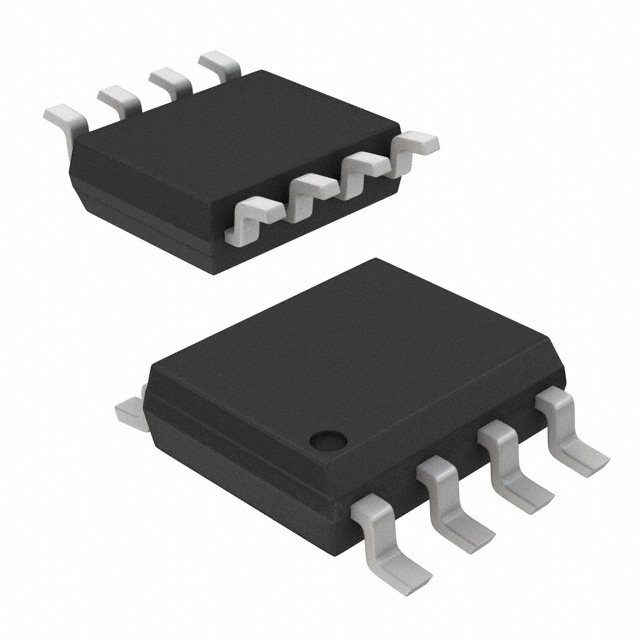GTLP2T152M
Product Overview
- Category: Electronic Component
- Use: Signal Level Translator
- Characteristics: High-speed, Low-voltage, Dual Supply Voltage
- Package: Surface Mount Technology (SMT)
- Essence: Translates signals between different voltage levels
- Packaging/Quantity: Tape and Reel, 3000 pieces per reel
Specifications
- Voltage Translation Range: 1.2V to 3.3V
- Input Voltage Levels: 1.2V, 1.8V, 2.5V, 3.3V
- Output Voltage Levels: 1.2V, 1.8V, 2.5V, 3.3V
- Maximum Data Rate: 400 Mbps
- Operating Temperature Range: -40°C to +85°C
Detailed Pin Configuration
The GTLP2T152M has a total of 16 pins arranged in a dual-row package. The pin configuration is as follows:
Pin 1: VCCA
Pin 2: GND
Pin 3: A1
Pin 4: A2
Pin 5: A3
Pin 6: A4
Pin 7: OE#
Pin 8: B1
Pin 9: B2
Pin 10: B3
Pin 11: B4
Pin 12: VCCB
Pin 13: GND
Pin 14: Y1
Pin 15: Y2
Pin 16: Y3
Functional Features
- Bidirectional voltage level translation
- Supports multiple input and output voltage levels
- High-speed data transmission up to 400 Mbps
- Low power consumption
- ESD protection on all pins
- RoHS compliant
Advantages and Disadvantages
Advantages
- Wide voltage translation range
- Dual supply voltage support
- High-speed data transmission
- ESD protection on all pins
Disadvantages
- Limited to surface mount technology (SMT) package
- Not suitable for applications requiring higher voltage levels
Working Principles
The GTLP2T152M is designed to translate signals between different voltage levels. It utilizes a combination of level shifters and voltage regulators to ensure accurate and reliable signal translation. The device detects the input voltage level and adjusts the output voltage accordingly, allowing seamless communication between devices operating at different voltage levels.
Detailed Application Field Plans
The GTLP2T152M is commonly used in various electronic systems where voltage level translation is required. Some of the application fields include:
- Mobile devices: Enables communication between low-voltage components and higher voltage peripherals.
- Industrial automation: Facilitates signal translation between different voltage domains in control systems.
- Automotive electronics: Allows integration of components operating at different voltage levels in automotive systems.
- Consumer electronics: Enables compatibility between devices with varying voltage requirements.
Detailed and Complete Alternative Models
- GTLP2T151M: Similar to GTLP2T152M but with a different pin configuration.
- GTLP2T153M: Supports higher voltage translation range up to 5V.
- GTLP2T154M: Provides additional features such as level shifting and voltage regulation.
Note: This is not an exhaustive list of alternative models. Please refer to the manufacturer's documentation for a complete list of available options.
Word count: 408 words
Lista 10 Vanliga frågor och svar relaterade till tillämpningen av GTLP2T152M i tekniska lösningar
Sure! Here are 10 common questions and answers related to the application of GTLP2T152M in technical solutions:
Q: What is GTLP2T152M? A: GTLP2T152M is a specific model number for a GTLP (Gunning Transceiver Logic Plus) integrated circuit, which is commonly used in high-speed digital communication systems.
Q: What are the key features of GTLP2T152M? A: GTLP2T152M features low voltage swing, low power consumption, high data rates, and compatibility with various transmission line technologies.
Q: In what applications can GTLP2T152M be used? A: GTLP2T152M is commonly used in applications such as high-speed data transmission, clock distribution, bus interfaces, and signal conditioning.
Q: What is the operating voltage range of GTLP2T152M? A: GTLP2T152M typically operates within a voltage range of 1.8V to 3.3V, making it suitable for use in low-power and battery-operated devices.
Q: Can GTLP2T152M handle high-speed data rates? A: Yes, GTLP2T152M is designed to handle high-speed data rates up to several gigabits per second, making it suitable for modern high-bandwidth applications.
Q: Does GTLP2T152M support bidirectional communication? A: No, GTLP2T152M is a unidirectional transceiver, meaning it can transmit or receive signals but not both simultaneously.
Q: What is the typical output impedance of GTLP2T152M? A: The typical output impedance of GTLP2T152M is around 50 ohms, which matches the characteristic impedance of common transmission lines.
Q: Can GTLP2T152M be used in multi-drop bus configurations? A: Yes, GTLP2T152M can be used in multi-drop bus configurations by connecting multiple transceivers to a shared bus line.
Q: Does GTLP2T152M have built-in ESD protection? A: Yes, GTLP2T152M typically includes built-in electrostatic discharge (ESD) protection to safeguard against damage from static electricity.
Q: Are there any specific layout considerations for using GTLP2T152M? A: Yes, it is recommended to follow the manufacturer's guidelines for PCB layout, including proper power supply decoupling, controlled impedance traces, and minimizing signal reflections.
Please note that the answers provided here are general and may vary depending on the specific implementation and datasheet specifications of GTLP2T152M.


